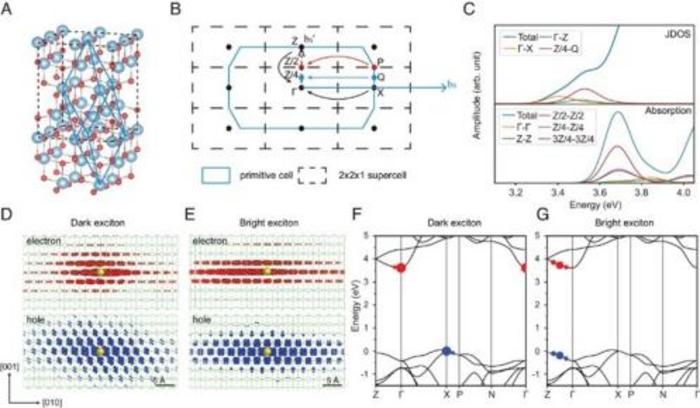A research team led by Prof. ZHAO Jin and Associate Prof. ZHENG Qijing from University of Science and Technology of China (USTC), in collaboration with Hrvoje Petek, a professor from the University of Pittsburgh, has uncovered the dynamics of bright-dark exciton transition in anatase TiO2. Their findings have been published in Proceedings of the National Academy of Sciences.

Credit: USTC
A research team led by Prof. ZHAO Jin and Associate Prof. ZHENG Qijing from University of Science and Technology of China (USTC), in collaboration with Hrvoje Petek, a professor from the University of Pittsburgh, has uncovered the dynamics of bright-dark exciton transition in anatase TiO2. Their findings have been published in Proceedings of the National Academy of Sciences.
Excitons, quasi-particles formed by the binding of electrons and holes in condensed matter systems via Coulomb interaction, exhibit distinct properties as bright and dark excitons. While bright excitons directly couple with light and play a pivotal role in light absorption, dark excitons, with their relatively longer lifetimes, hold significance in quantum information processing, Bose-Einstein condensation, and light-energy harvesting.
This study, with the help of GW plus the real- time Bethe–Salpeter equation combined with the nonadiabatic molecular dynamics (GW + rtBSE- NAMD), explored the formation dynamics on how the optically excited bright to the strongly bound momentum-forbidden dark excitons in anatase TiO2, a semiconductor material renowned for its exceptional light absorption capabilities and its ability to activate bright excitons under light excitation. In the meantime, due to the material’s indirect band gap nature, bright excitons ultimately relax to the band edges, forming dark excitons.
The bright-dark exciton transition exhibited a novel pathway upon considering many-body effects within the excitons—the interaction between electrons and holes. This revelation unveiled an extended timescale for the transition process, where bright excitons transform into dark excitons within approximately 100 femtoseconds, several times fastaer than previously understood. Crucially, the many-body effects within excitons played a pivotal role during this transition.
This study sheds light on how semiconductor materials’ excitonic dynamics are affected by many-body interactions, offering crucial insights for designing light-based devices and energy materials. It also exemplifies the collaborative efforts and innovative computational approaches in unraveling the intricate dynamics of excitons, paving the way for advancements in material science and technology.
Journal
Proceedings of the National Academy of Sciences
DOI
10.1073/pnas.2307671120
Article Title
Ultrafast many-body bright–dark exciton transition in anatase TiO2
Article Publication Date
13-Nov-2023




